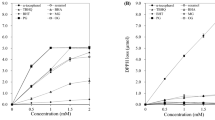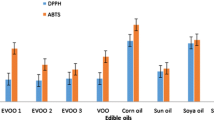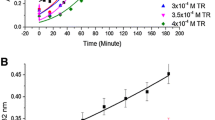Abstract
Oxidized lipids can decrease the absorbance of DPPH in isooctane. Changes of aldehydes, which can react with DPPH radicals, in oxidized linoleic acid and lard were monitored using 2,4-dinitrophenylhydrazine (DNPH) derivatization and HPLC. As thermal oxidation time increased in linoleic acid, peaks of propanal, pentanal, and hexanal increased proportionally. The correlation coefficient (r) of among DPPH absorbance and peak areas of DNPH derivatized lard for 360 min was −0.941. Peaks of t-2-heptenal and pentanal showed relatively high correlation with the changes of DPPH absorbance during lard oxidation. Quantity of oxidized products with radical scavenging ability in lipids can be determined by DNPH derivatization with HPLC analysis.
Similar content being viewed by others
References
Min DB, Boff JM. Lipid oxidation of edible oil. Vol. 2, pp. 335–364. In: Food Lipids. Akoh CC, Min DB (eds). 2nd ed. Marcel Dekker, New York, NY, USA (2002)
Nawar WW. Lipids. Vol. 3, pp. 226–319. In: Food Chemistry. Fennema OR (ed). Marcel Dekker, New York, NY, USA (1996)
Laguerre M, Lecomte J, Villeneuve P. Evaluation of the ability of antioxidants to counteract lipid oxidation: Existing methods, new trends, and challenges. Prog. Lipid Res. 46: 244–282 (2007)
Shahidi F, Wanasundara UN. Methods of measuring oxidative rancidity in fats and oils. pp. 377–396. In: Food Lipids. Akoh CC, Min DB (eds). Marcel Dekker, New York, NY, USA (1998)
Niki E. Assessment of antioxidant capacity in vitro and in vivo. Free Radical Bio. Med. 49: 503–515 (2010)
Alamed J, Chaiyasit W, McClements DJ, Decker EA. Relationships between free radical scavenging and antioxidant activity in foods. J. Agr. Food Chem. 57: 2969–2976 (2009)
Estevez M, Cava R. Effectiveness of rosemary essential oil as an inhibitor of lipid and protein oxidation: Contradictory effects in different types of frankfurters. Meat Sci. 72: 348–355 (2006)
Lee JM, Chung H, Chang PS, Lee JH. Development of a method predicting the oxidative stability of edible oils using 2,2-diphenyl-1-picrylhydrazyl (DPPH). Food Chem. 103: 662–669 (2007)
Yeo JD, Jeong MK, Park CU, Lee JH. Comparing antioxidant effectiveness of natural and synthetic free radical scavengers in thermally-oxidized lard using DPPH method. J. Food Sci. 75: C258–C262 (2010)
Yeo JD, Park JW, Lee JH. Evaluation of antioxidant capacity of sesamol in lard model systems with different oxidation temperature. Eur. J. Lipid Sci. Tech. 113: 910–915 (2011)
Jeong MK, Yeo JD, Kim MJ, Lee JH. Aldehydes from oxidized lipids can react with free radical scavenging compounds in isooctane systems. J. Am. Oil Chem. Soc. 89: 1831–1838 (2012)
Ha DO, Yeo JD, Kang ST, Kim MJ, Lee JH. Sodium azide and metal chelator effects on 2,2-diphenyl-1-picrylhydrazyl (DPPH) radical scavenging compounds from methylene blue photosensitized. Eur. J. Lipid Sci. Tech. 114: 780–786 (2012)
Uchiyama S, Inaba Y, Kunugita N. Derivatization of carbonyl compounds with 2,4-dinitrophenylhydrazine and their subsequent determination by high performance liquid chromatography. J. Chromatogr. B 879: 1282–1289 (2011)
Yeo JD, Jeong MK, Lee JH. Correlation between changes of free radical compounds and DPPH absorbance during thermal oxidation. Food Sci. Biotechnol. 21: 199–203 (2012)
Ochs SM, Fasciotti M, Barreto RP, Figueiredo NG, Albuquerque FC, Pontes Massa MCG, Gabardo I, Pereira Netto AD. Optimization and comparison of HPLC and RRLC conditions for the analysis of carbony-DNPH derivatives. Talanta 81: 521–529 (2010)
Frankel EN, Selke E, Neff WE, Miyashita K. Autoxidation of polyunsaturated triacylglycerols. IV. Volatile decomposition products from triacylglycerols containing linoleate and linolenate. Lipids 27: 442–446 (1992)
Chaiyasit W, McClements DJ, Decker EA. The relationship between the physicochemical properties of antioxidants and their ability to inhibit lipid oxidation in bulk oil and oil-in-water emulsions. J. Agr. Food Chem. 53: 4982–4988 (2005)
Lee JH, Decker EA. Effects of metal chelators, sodium azide, and superoxide dismutase (SOD) on the oxidative stability in riboflavin photosensitized O/W emulsion systems. J. Agr. Food Chem. 59: 6271–6276 (2011)
Author information
Authors and Affiliations
Corresponding author
Rights and permissions
About this article
Cite this article
Jeong, M.K., Yeo, J., Jang, E.Y. et al. Monitoring of radical scavenging compounds from oxidized lipids (RSOL) by 2,4-dinitrophenylhydrazine (DNPH) derivatization in thermally oxidized linoleic acid and lard systems. Food Sci Biotechnol 22 (Suppl 1), 161–165 (2013). https://doi.org/10.1007/s10068-013-0062-4
Received:
Revised:
Accepted:
Published:
Issue Date:
DOI: https://doi.org/10.1007/s10068-013-0062-4




